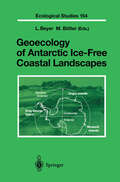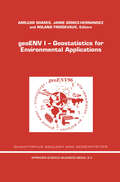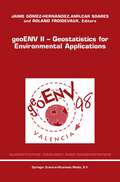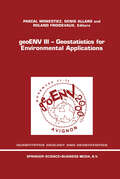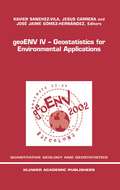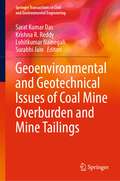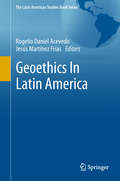- Table View
- List View
Geoecology: An Evolutionary Approach
by Richard HuggettAnimals, plants and soils interact with one another, with the terrestrial spheres, and with the rest of the Cosmos. On land, this rich interaction creates landscape systems or geoecosystems. Geoecology investigates the structure and function of geoecosystems, their components and their environment. The author develops a simple dynamic systems model, the `brash' equation, to form the conceptual framework for the book suggesting an `ecological' and `evolutionary' approach. Exploring internal of `ecological' interactions between geoecosystems and their near-surface environments - the atmosphere, hydrosphere, toposhere, and lithosphere - and external influences, both geological and cosmic, Geoecology presents geoecosystems as dynamic entities constantly responding to changes within themselves and their surroundings. An `evolutionary' view emerges of geoecological systems, and the animals, plants, and soils comprising them, providing a new way of thinking for the whole environmental complex and the rich web of interdependencies contained therein.
Geoecology: An Evolutionary Approach
by Richard HuggettAnimals, plants and soils interact with one another, with the terrestrial spheres, and with the rest of the Cosmos. On land, this rich interaction creates landscape systems or geoecosystems. Geoecology investigates the structure and function of geoecosystems, their components and their environment. The author develops a simple dynamic systems model, the `brash' equation, to form the conceptual framework for the book suggesting an `ecological' and `evolutionary' approach. Exploring internal of `ecological' interactions between geoecosystems and their near-surface environments - the atmosphere, hydrosphere, toposhere, and lithosphere - and external influences, both geological and cosmic, Geoecology presents geoecosystems as dynamic entities constantly responding to changes within themselves and their surroundings. An `evolutionary' view emerges of geoecological systems, and the animals, plants, and soils comprising them, providing a new way of thinking for the whole environmental complex and the rich web of interdependencies contained therein.
Geoecology of Antarctic Ice-Free Coastal Landscapes (Ecological Studies #154)
by L Beyer M. BölterResearch in Antarctica in the past two decades has fundamentally changed our perceptions of the southern continent. This volume describes typical terrestrial environments of the maritime and continental Antarctic. Life and chemical processes are restricted to small ranges of ambient temperature, availability of water and nutrients. This is reflected not only in life processes, but also in those of weathering and pedogenesis. The volume focuses on interactions between plants, animals and soils. It includes aspects of climate change, soil development and biology, as well as above- and below-ground results of interdisciplinary research projects combining data from botany, zoology, microbiology, pedology, and soil ecology.
Geoecology of Landscape Dynamics (Advances in Geographical and Environmental Sciences)
by R. B. Singh Manish Kumar Seema SahdevThis book provides an overview of the ecological indicators of landscape dynamics in the context of geographical landscape integration. Landscape dynamics depicts every change that occurs in the physical, biological, and cognitive assets of a landscape. To understand and interpret the complex physical, biological, and cognitive phenomena of landscapes, it is necessary to operate conceptually and practically on a broad range of spatial and temporal scales. Rapid land use changes have become a concern to environmentalists and planners because of their impacts on the natural ecosystem, which further determines socioeconomic dynamics. In this regard, the book discusses case studies that share new insights into how landscape patterns and processes impact small creatures, and how small creatures in turn influence landscape structure and composition. In turn, the relevant aspects of land use and land cover dynamics are covered, and the multi-faceted relationship between the substrata and ecological community is highlighted. The book is unique in its focus on the application of spatial informatics such as automatic building extraction from high-resolution imagery; a soil resource inventory for meeting the challenges of land degradation; hydrological modeling; the temporal variation analysis of glacier area and the identification and mapping of glacial lakes; morphometric analysis of river basins; and the monitoring and modeling of urban sprawl, among other features.
Geoelectromagnetic Investigation of the Earth’s Crust and Mantle
by I.I. RokityanskyElectrical conductivity is a parameter which characterizes composition and physical state of the Earth's interior. Studies of the state equations of solids at high temperature and pressure indicate that there is a close relation be tween the electrical conductivity of rocks and temperature. Therefore, measurements of deep conductivity can provide knowledge of the present state and temperature of the Earth's crust and upper mantle matter. Infor mation about the temperature of the Earth's interior in the remote past is derived from heat flow data. Experimental investigation of water-containing rocks has revealed a pronounced increase of electrical conductivity in the temperature range D from 500 to 700 DC which may be attributed to the beginning of fractional melting. Hence, anomalies of electrical conductivity may be helpful in identitying zones of melting and dehydration. The studies of these zones are perspective in the scientific research of the mobile areas of the Earth's crust and upper mantle where tectonic movements, processes ofthe region al metamorphism and of forming mineral deposits are most intensive. Thus, in the whole set of research on physics of the Earth the studies of electrical conductivity of deep-seated rocks appear, beyond doubt, very important.
Geoelektronik: Angewandte Elektronik in der Geophysik, Geologie, Prospektion, Montanistik und Ingenieurgeologie
by Wolfram Bitterlich Hans WöbkingGeoengineering Responses to Climate Change: Selected Entries from the Encyclopedia of Sustainability Science and Technology
by Tim Lenton and Naomi VaughanFailure by the international community to make substantive progress in reducing CO2 emissions, coupled with recent evidence of accelerating climate change, has brought increasing urgency to the search for additional remediation approaches. This book presents a selection of state-of-the-art geoengineering methods for deliberately reducing the effects of anthropogenic climate change, either by actively removing greenhouse gases from the atmosphere or by decreasing the amount of sunlight absorbed at the Earth’s surface. These methods contrast with more conventional mitigation approaches which focus on reducing emissions of greenhouse gases, especially carbon dioxide. Geoengineering technologies could become a key tool to be used in conjunction with emissions reduction to limit the magnitude of climate change. Featuring authoritative, peer-reviewed entries from the Encyclopedia of Sustainability Science and Technology, this book presents a wide range of climate change remediation technologies.
Geoengineering, the Anthropocene and the End of Nature
by Jeremy BaskinThis book takes a critical look at solar geoengineering as an acceptable means for addressing climate change. Baskin explores the assumptions and imaginaries which animate ‘engineering the climate’ and discusses why this climate solution is so controversial. The book explains geoengineering’s past, its revival in the mid-2000s, and its future prospects including its shadow presence in the Paris climate accord. The main focus however is on dissecting solar geoengineering today – its rationales, underpinning knowledge, relationship to power, and the stance towards nature which accompanies it. Baskin explores three competing imaginaries associated with geoengineering: an Imperial imaginary, an oppositional Un-Natural imaginary, and a conspiratorial Chemtrail imaginary. He seeks to explain why solar geoengineering has struggled to gain approval and why resistance to it persists, despite the support of several powerful actors. He provocatively suggests that reconceptualising our present as the Anthropocene might unwittingly facilitate the normalisation of geoengineering by providing a sustaining socio-technical imaginary. This book is essential reading for those interested in climate policy, political ecology, and science & technology studies.
geoENV I — Geostatistics for Environmental Applications: Proceedings of the Geostatistics for Environmental Applications Workshop, Lisbon, Portugal, 18–19 November 1996 (Quantitative Geology and Geostatistics #9)
by A. O. Soares Jaime Gómez-Hernández Roland FroidevauxGeoENV96, the First European Conference on Geostatistics for Environmental Applications held in Lisbon, was conceived to bring together researchers, mostly from, but not limited to Europe, working on environmental issues approached by geostatistical methods. Papers were attracted from fields as diverse as hydrogeology. biology, soil sciences, air pollution or ecology. It is clear that there is a lot of activity on geostatistics for environmental applications as the collection of papers in this book reveals. GeoENV96 was successful in the number and quality of the papers presented which surpassed the initial expectations. There is still a large dispersion on the level of application of geostatistics in the different areas. To help in spreading the most novel applications of geostatistics across disciplines and to discuss the specific problems related to the application of geostatistics to environmental applications, geoENV96 is intended to set the pace and to be the first of a series of biennial meetings. The pace is set, now let us wait for geoENV98. Lisbon, November 1996 The Executive Committee: Jaime Gomez-Hernandez Roland Froidevaux Amflcar Soares TABLE OF CONTENTS Foreword .................................................. Vll Hydrology, Groundwater, Groundwater Contaminantion Equivalent Transmissivities in Heterogeneous Porous Media under Radially Convergent Flow X. Sanchez-Vila, c.L. Axness and J. Carrera .......................... .
geoENV II — Geostatistics for Environmental Applications: Proceedings of the Second European Conference on Geostatistics for Environmental Applications held in Valencia, Spain, November 18–20, 1998 (Quantitative Geology and Geostatistics #10)
by Jaime Gómez-Hernández A. O. Soares Roland FroidevauxThe Second European Conference on Geostatistics for Environmental Ap plications took place in Valencia, November 18-20, 1998. Two years have past from the first meeting in Lisbon and the geostatistical community has kept active in the environmental field. In these days of congress inflation, we feel that continuity can only be achieved by ensuring quality in the papers. For this reason, all papers in the book have been reviewed by, at least, two referees, and care has been taken to ensure that the reviewer comments have been incorporated in the final version of the manuscript. We are thankful to the members of the scientific committee for their timely review of the scripts. All in all, there are three keynote papers from experts in soil science, climatology and ecology and 43 contributed papers providing a good indication of the status of geostatistics as applied in the environ mental field all over the world. We feel now confident that the geoENV conference series, seeded around a coffee table almost six years ago, will march firmly into the next century.
geoENV III — Geostatistics for Environmental Applications: Proceedings of the Third European Conference on Geostatistics for Environmental Applications held in Avignon, France, November 22–24, 2000 (Quantitative Geology and Geostatistics #11)
by Pascal Monestiez Denis Allard Roland FroidevauxThis volume contains selected contributions from geoENV III - the Third European Conference on Geostatistics for Environmental Sciences, held in Avignon, France in November 2000. This third book of the geoENV series illustrates the new methodological developments in geostatistics, as applied to environmental sciences, which have occurred during the last two years. It also presents a wide variety of practical environmental applications which will be of interest to both researchers and practitioners. The book starts with two keynote papers on hydrogeology and on climatology and atmospheric pollution, followed by forty contributions. The content of this book is foremost practical. The editors have endeavored to compile a set of papers in which the readers could perceive how geostatistics is applied within environmental sciences. A few selected methodological and theoretical contributions are also included. The papers are organised in the following sections: Air Pollution / Climate; Environment; Health / Ecology; Hydrology; Methods; Soil Science / Site Remediation. presenting applications varying from delineation of hazardous areas, monitoring water quality, space-time modeling of sand beaches, areal rainfall estimation, air pollution monitoring, multivariate conditional simulation, soil texture analysis, fish abundance analysis, tree productivity index estimation, radionuclide migration analysis, wombling procedure, tracer tests modeling, direct sequential co-simulation to stochastic modeling of flow and transport. Audience: This publication will be of great interest and practical value to geostatisticians working both in academia and in industry.
geoENV IV — Geostatistics for Environmental Applications: Proceedings of the Fourth European Conference on Geostatistics for Environmental Applications held in Barcelona, Spain, November 27–29, 2002 (Quantitative Geology and Geostatistics #13)
by Xavier Sanchez-Vila Jesus Carrera Jaime Gómez-HernándezThe fourth edition of the European Conference on Geostatistics for Environmental Applications (geoENV IV) took place in Barcelona, November 27-29, 2002. As a proof that there is an increasing interest in environmental issues in the geostatistical community, the conference attracted over 100 participants, mostly Europeans (up to 10 European countries were represented), but also from other countries in the world. Only 46 contributions, selected out of around 100 submitted papers, were invited to be presented orally during the conference. Additionally 30 authors were invited to present their work in poster format during a special session. All oral and poster contributors were invited to submit their work to be considered for publication in this Kluwer series. All papers underwent a reviewing process, which consisted on two reviewers for oral presentations and one reviewer for posters. The book opens with one keynote paper by Philippe Naveau. It is followed by 40 papers that correspond to those presented orally during the conference and accepted by the reviewers. These papers are classified according to their main topic. The list of topics show the diversity of the contributions and the fields of application. At the end of the book, summaries of up to 19 poster presentations are added. The geoENV conferences stress two issues, namely geostatistics and environmental applications. Thus, papers can be classified into two groups.
geoENV VI – Geostatistics for Environmental Applications (Quantitative Geology and Geostatistics #15)
by Amílcar Soares Maria João Pereira Roussos DimitrakopoulosThis volume contains 40 selected full-text contributions from the Sixth European Conference on Geostatistics for Environmental Applications, geoENV IV, held in Rhodes, Greece, October 25-26, 2006. The objective of the editors was to compile a set of papers from which the reader could perceive how geostatistics is applied within the environmental sciences. A few selected theoretical contributions are also included.
geoENV VII – Geostatistics for Environmental Applications: Proceedings Of The Seventh European Conference On Geostatistics For Environmental Applications (Quantitative Geology and Geostatistics #16)
by P. M. Atkinson C. D. LloydThis volume brings together selected contributions from geoENV 2008, the 7th International Conference on Geostatistics for Environmental Applications, held in Southampton, UK. It presents the state-of-the-art in geostatistics for the environmental sciences.
Geoenvironment, An Introduction
by U. AswathanaraynaThe focus of this book is on the management of the geoenvironment. It seeks to explain how, through an understanding of the environmental processes that take place in rocks, soils, waters, sediments, air and so on, the resources contained in them could be managed sustainably. Topics covered in the book include: Ecologically-sustainable industrial development; dynamics of the geoenvironment; the impact of mining on rocks, soils, water and biota; the natural radiation environment; the use of geotechnology to mitigate the consequences of natural disasters and the disposal of various kinds of waste, particulary hazardous waste. The models proposed by the World Bank on how to make environemntal amelioration economcially viable are also looked at.
Geoenvironment, An Introduction
by U. AswathanaraynaThe focus of this book is on the management of the geoenvironment. It seeks to explain how, through an understanding of the environmental processes that take place in rocks, soils, waters, sediments, air and so on, the resources contained in them could be managed sustainably. Topics covered in the book include: Ecologically-sustainable industrial development; dynamics of the geoenvironment; the impact of mining on rocks, soils, water and biota; the natural radiation environment; the use of geotechnology to mitigate the consequences of natural disasters and the disposal of various kinds of waste, particulary hazardous waste. The models proposed by the World Bank on how to make environemntal amelioration economcially viable are also looked at.
Geoenvironmental and Geotechnical Issues of Coal Mine Overburden and Mine Tailings (Springer Transactions in Civil and Environmental Engineering)
by Sarat Kumar Das Krishna R. Reddy Lohitkumar Nainegali Surabhi JainThis contributed book edited by leading global experts focuses on the geoenvironmental and geotechnical issues of coal mine overburden and mine tailings and its unengineered dumping. It aims to provide knowledge-based information for diverse readers to assess, monitor, and manage coal mine overburden and mine tailings in various engineering applications while highlighting efficient solutions to reutilize the waste and conserve natural resources leading to sustainable development. The content also assesses mine backfilling, techniques to stabilize mine tailing storage facilities, mineral carbonation of mine tailings, landfill liners and barrier systems, reclamation of coal mine overburden, and geochemical, microbial, and environmental sustainability assessment, among others. This book is a useful resource for those in academia and industry.
Geoenvironmental Changes in the Cordillera Blanca, Peru (Geoenvironmental Disaster Reduction)
by Vít Vilímek Bryan Mark Adam EmmerThis book focuses on Peru’s highest and most glacierized mountain range – the Cordillera Blanca. This mountain range experienced numerous disasters in the past (e.g. lake Palcacocha outburst in 1941, earthquake-induced ice and rock avalanche from Mt. Huascarán in 1970) and has attracted the attention of researchers from around the world. The 15 chapters of the book span from broadly thematic topics of geology, geomorphology, climate, hydrology and hydrogeology, lakes, glaciation, and environmental settings to more specific topics and emergent themes of relevance for the Cordillera Blanca, including studies of various types of natural hazards (landslides, GLOFs). While most of the chapters focus on biophysical processes of the natural environment, several chapters explore the complex interactions between humans and environmental factors, providing insights and perspectives from social science and the humanities. This book offers an unprecedentedly comprehensive overview of the state-of-the-art knowledge about the geo-environmental changes in the Cordillera Blanca.
Geoenvironmental Engineering: Principles and Applications
by Hilary I. Inyang Lakshmi Reddi"Applies science and engineering principles to the analysis, design, and implementation of technical schemes to characterize, treat, modify, and reuse/store waste and contaminated media. Includes site remediation."
Geoenvironmental Engineering: Proceedings of EGRWSE-23, Volume 1 (Lecture Notes in Civil Engineering #508)
by Krishna R. Reddy Arvind Kumar Agnihotri Ajay BansalThis book contains peer-reviewed and selected papers presented during the International Conference on Environmental Geotechnology, Recycled Waste Materials and Sustainable Engineering (EGRWSE) 2023, held at NIT Jalandhar. It discusses the recent innovations, trends, concerns, practical challenges encountered, and the solutions adopted in waste management and engineering, geotechnical and geoenvironmental engineering, infrastructure engineering and sustainable engineering. This book can serve as a useful resource for researchers, educators, policymakers, and professionals working in the field of civil engineering, chemical engineering, environmental sciences, and public policy.
Geoenvironmental Practices and Sustainability: Linkages and Directions (Developments in Geotechnical Engineering)
by G.L. Sivakumar Babu Krishna R. Reddy Anirban De Manoj DattaThis volume is a compilation on issues related to sustainable practices in geo-environmental engineering, particularly as applying to developing nations such as India. While, the developed world has already developed some solutions such as landfills, developments in landfills, barriers and liners in the North America and waste-to-energy and waste incineration in Europe, developing countries like India are trying to figure out ways which suit the present condition without compromising the future needs and comforts. This volume presents case studies on the various problems and solutions adopted for different sites. Although a common approach for all the problems is not feasible or recommend, this collection aims to provide a compendium on the current efforts underway and to help achieve common ground for the practitioners and researchers involved. The works included here give insight to the possible development of resilient and sustainable structures (like offshore wind turbines) and energy geotechnics. The book covers topics such as liners and barrier systems, use of recycled and waste materials, waste management and hazard assessment, sustainable infrastructure, and sustainability and the environment. The contents of this book will be useful to researchers and professionals working in geo-environmental engineering. The book will also be useful to policy makers interested in understanding geotechnical concerns related to sustainable development.
Geoethics: Manifesto for an Ethics of Responsibility Towards the Earth
by Silvia Peppoloni Giuseppe Di CapuaThis book outlines the current development of geoethical thinking, proposing to the general public reflections and categories useful for understanding the ethical, cultural, and societal dimensions of anthropogenic global changes. Geoethics identifies and orients responsible behaviors and actions in the management of natural processes, redefining the human interaction with the Earth system based on a critical, scientifically grounded, and pragmatic approach. Solid scientific knowledge and a philosophical reference framework are crucial to face the current ecological disruption. The scientific perspective must be structured to help different human contexts while respecting social and cultural diversity. It is impossible to respond to global problems with disconnected local actions, which cannot be proposed as standard and effective operational models. Geoethics tries to overcome this fragmentation, presenting Earth sciences as the foundation of responsible human action toward the planet. Geoethics is conceived as a rational and multidisciplinary language that can bind and concretely support the international community, engaged in resolving global environmental imbalances and complex challenges, which have no national, cultural, or religious boundaries that require shared governance. Geoethics is proposed as a new reading key to rethinking the Earth as a system of complex relationships, in which the human being is an integral part of natural interactions.
Geoethics In Latin America (The Latin American Studies Book Series)
by Rogelio Daniel Acevedo Jesús Martínez FríasThis book studies geoethics in Latin America and offers comprehensive research on geoethics and geoeducation. Its respective chapters explore geoethics in relation to UNESCO geoparks, mining activities in Latin America, natural hazards and risk management. Geoethics is a key discipline in the field of Earth and Planetary Sciences, and not only includes scientific, technological, methodological and social-cultural aspects, but also addresses the need to consider appropriate protocols, scientific integrity issues and a code of good practice when studying the abiotic world.The position of Latin America’s recently created geoethics associations is based on protection of the environment, together with a reassurance that the balance of nature and the rights of human beings to enjoy it will be preserved.
Geoethics in Peru: A Pathway for Latin America (SpringerBriefs in Geoethics)
by Sandra Paula Villacorta ChambiThe book discusses geoscience issues in Peru from a geoethical perspective, based on the leading experience of the Peruvian section of the International Association for Promoting Geoethics, in its seven years of activity.The introduction will present past and current activities to promote geoethics in Peru, such as the organization of the MinerLima exhibition (that has teaching purposes); the implementation of geoethics in georisk communication with vulnerable populations, as well as the promotion of adequate knowledge about national geological heritage. The other chapters will describe the main geoethical issues in Peru, related to georisk management and communication, mining, paleontology and geoheritage, geoducation. Some proposals for actions that should be taken to improve societal awareness and to make progress in problem-solving from a geoethical perspective will be discussed for each issue.In the final chapter Peruvian geoescience implications and new roles for geoscientists will be discussed, providing clues to their participation in the management of socio-environmental problems that affect Latin American region. It will be also underlined how geoethics represents a new theoretical and practical approach that may contribute in the current process to modernize geoscience education in Latin America.In this sense, this publication provides a solid base to apply the theoretical framework of Geoethics in Peru that may be suggested as an example to promote geoethics in other Latin American countries. As a result, the need to inform and prepare the population of growing countries such as Peru to face the problems of the modern world is evident.In order to attract more readers in Latin America, each chapter will be provided with a summary in Spanish.

